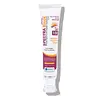What's inside
What's inside
 Key Ingredients
Key Ingredients

 Benefits
Benefits

 Concerns
Concerns

 Ingredients Side-by-side
Ingredients Side-by-side

Water
Skin ConditioningGlycerin
HumectantPEG-10 Glyceryl Stearate
EmulsifyingCaprylic/Capric Triglyceride
MaskingCeramide Ns
Skin ConditioningStearic Acid
CleansingCeteareth-29
CleansingPropylene Glycol
HumectantCeramide AP
Skin ConditioningHyaluronic Acid
HumectantTocopheryl Acetate
AntioxidantAloe Barbadensis Leaf Extract
EmollientTitanium Dioxide
Cosmetic ColorantPhenoxyethanol
PreservativeCaprylyl Glycol
EmollientEthylhexyl Methoxycinnamate
UV AbsorberCarbomer
Emulsion StabilisingCyclomethicone
EmollientC12-15 Alkyl Benzoate
AntimicrobialTriethanolamine
BufferingDisodium EDTA
Water, Glycerin, PEG-10 Glyceryl Stearate, Caprylic/Capric Triglyceride, Ceramide Ns, Stearic Acid, Ceteareth-29, Propylene Glycol, Ceramide AP, Hyaluronic Acid, Tocopheryl Acetate, Aloe Barbadensis Leaf Extract, Titanium Dioxide, Phenoxyethanol, Caprylyl Glycol, Ethylhexyl Methoxycinnamate, Carbomer, Cyclomethicone, C12-15 Alkyl Benzoate, Triethanolamine, Disodium EDTA
Water
Skin ConditioningStyrene/Acrylates Copolymer
Silica
AbrasiveBeeswax
Emulsion StabilisingCyclopentasiloxane
EmollientEthylhexylglycerin
Skin ConditioningGlyceryl Stearate
EmollientMethylisothiazolinone
PreservativeButyl Methoxydibenzoylmethane
UV AbsorberHomosalate
Skin ConditioningEthylhexyl Salicylate
UV AbsorberOctocrylene
UV AbsorberBenzophenone-4
UV AbsorberTitanium Dioxide
Cosmetic ColorantZinc Oxide
Cosmetic ColorantPEG-100 Stearate
Acrylates/Dimethicone Copolymer
Skin ConditioningAcrylates/C10-30 Alkyl Acrylate Crosspolymer
Emulsion StabilisingChlorphenesin
AntimicrobialTriethanolamine
BufferingDiethylhexyl 2,6-Naphthalate
EmollientDipotassium Glycyrrhizate
HumectantDisodium EDTA
BHT
AntioxidantWater, Styrene/Acrylates Copolymer, Silica, Beeswax, Cyclopentasiloxane, Ethylhexylglycerin, Glyceryl Stearate, Methylisothiazolinone, Butyl Methoxydibenzoylmethane, Homosalate, Ethylhexyl Salicylate, Octocrylene, Benzophenone-4, Titanium Dioxide, Zinc Oxide, PEG-100 Stearate, Acrylates/Dimethicone Copolymer, Acrylates/C10-30 Alkyl Acrylate Crosspolymer, Chlorphenesin, Triethanolamine, Diethylhexyl 2,6-Naphthalate, Dipotassium Glycyrrhizate, Disodium EDTA, BHT
Ingredients Explained
These ingredients are found in both products.
Ingredients higher up in an ingredient list are typically present in a larger amount.
Disodium EDTA plays a role in making products more stable by aiding other preservatives.
It is a chelating agent, meaning it neutralizes metal ions that may be found in a product.
Disodium EDTA is a salt of edetic acid and is found to be safe in cosmetic ingredients.
Learn more about Disodium EDTATitanium dioxide is a mineral UV filter widely used in sunscreens and cosmetics.
It is one of only two UV filters officially classified as “mineral” by regulatory agencies, the other being zinc oxide.
Titanium dioxide provides broad-spectrum protection mostly in the UVB and UVAII range, with some protection in the UVAI range.
While its UVA protection isn’t as strong as zinc oxide’s, the difference is minor.
A common myth is that mineral UV filters reflect UV light. However, modern research shows titanium dioxide absorbs UV radiation like chemical filters (~95% absorption & 5% reflection).
Thanks to its non-irritating nature, titanium dioxide is suitable for sensitive, acne-prone, or redness-prone skin. It is unlikely to cause "eye sting" like other sunscreen ingredients.
A major drawback of this ingredient is its white cast and thick texture. This is why mineral sunscreens often leave a white cast and are less cosmetically elegant than chemical/hybrid sunscreens.
To improve white cast and spreadability, micronized or nano-sized titanium dioxide is often used.
There are ongoing concerns surrounding nano-titanium oxide's impact on marine ecosystems.
There is no conclusive evidence that any form of titanium oxide (or any other sunscreen ingredients) will cause harm to marine ecosystems or coral reefs. The science is still developing but many consumers are keeping a close eye on this issue.
Please note, many destinations have reef-safety sunscreen rules. For instance, the U.S. Virgin Islands advises all visitors to use non-nano mineral sunscreens.
Nano mineral sunscreens once raised safety concerns about absorption into skin.
Extensive research has shown that they do not penetrate healthy or damaged skin; they remain safely on the surface and the top layer of dead skin (stratum corneum).
You'll likely find titanium dioxide bundled with alumina, silica, or dimethicone. These ingredients help make titanium dioxide highly photostable; this prevents it from interacting with other formula components under UV light.
Learn more about Titanium DioxideTriethanolamine is an emulsifier and pH adjuster. It is created using ethylene oxide and ammonia. This gives Triethanolamine a nitrogen core and a similar scent to ammonia.
As an emulsifier, it prevents ingredients from separating and enhances texture by adding volume to a product.
PH adjusters are common in cosmetic products. The pH of a product can affect the effectiveness of other ingredients. A product with a high pH may also irritate the skin.
Learn more about TriethanolamineWater. It's the most common cosmetic ingredient of all. You'll usually see it at the top of ingredient lists, meaning that it makes up the largest part of the product.
So why is it so popular? Water most often acts as a solvent - this means that it helps dissolve other ingredients into the formulation.
You'll also recognize water as that liquid we all need to stay alive. If you see this, drink a glass of water. Stay hydrated!
Learn more about Water